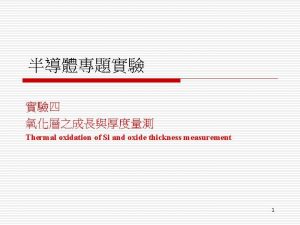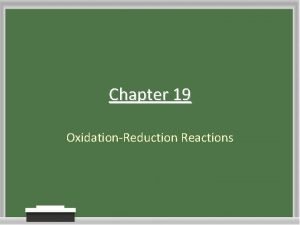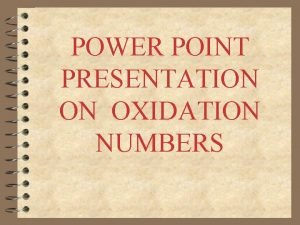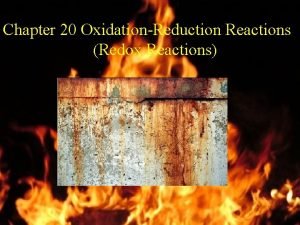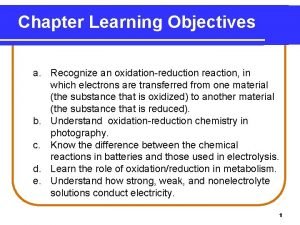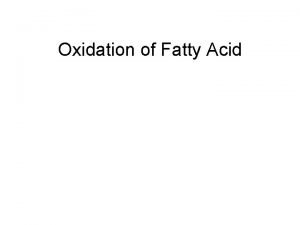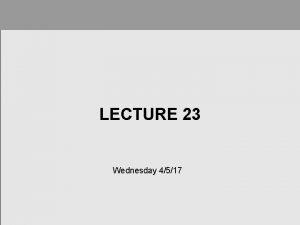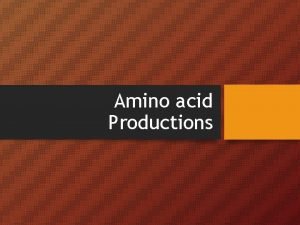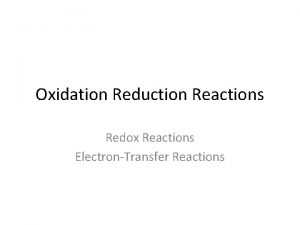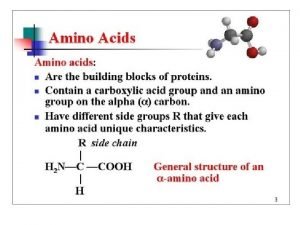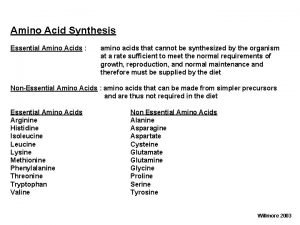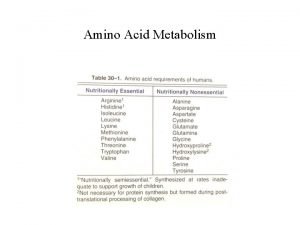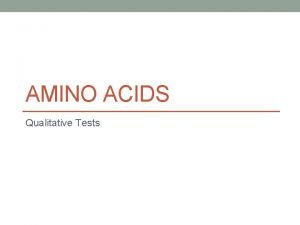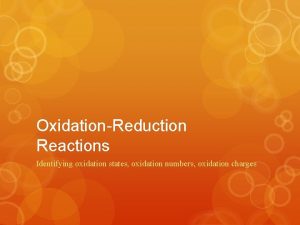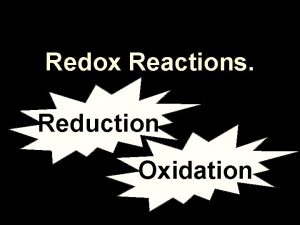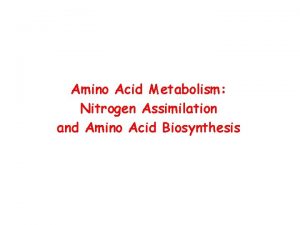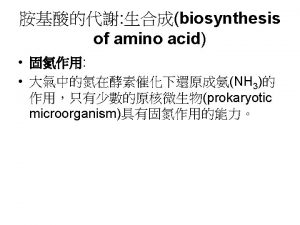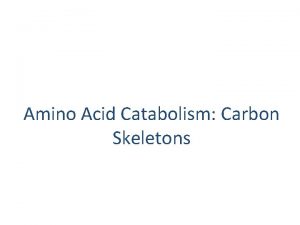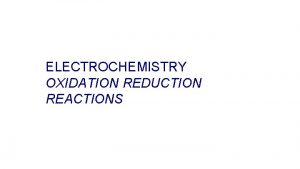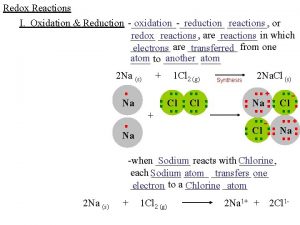LECTURE 23 Wednesday 4517 AMINO ACID REACTIONS Oxidation

















- Slides: 17

LECTURE 23 Wednesday 4/5/17

AMINO ACID REACTIONS • Oxidation of cysteine, the only –SH containing amino acid, forms a

AMINO ACID REACTIONS (continued) • formation enables amino acids to make polymers by forming amide (peptide) linkages.

AMINO ACID REACTIONS (continued) • Dipeptides are compounds made of • The order of linkage is important because two different dipeptides can be formed when two unique amino acids react.

AMINO ACID REACTIONS (continued) • • are an amino acid polymer of short chain length. is an intermediate chain length polymer with less than 50 amino acids. • A is a polymer with more than 50 amino acids. • An amino acid is an amino acid that is part of a peptide, polypeptide, or protein chain. • By convention, peptides are written

IMPORTANT PEPTIDES • Vasopressin and oxytocin are hormones released by the pituitary gland classified as nonapetides. • Both have • They differ only in 3 rd and 8 th amino acids. • Vasopressin (antidiuretic hormone) decreases urine formation. • Oxytocin causes uterine contractions.

IMPORTANT PEPTIDES (continued) • Adrenocorticotropic (ACTH) hormone is released by the pituitary gland. • ACTH contains 39 amino acids. • ACTH has • ACTH regulates the production of steroids in the cortex of the adrenal gland.

IMPORTANT PEPTIDES (continued)

PROTEIN SIZE

PROTEIN SIZE (continued) • Proteins: • • have molecular weights of ~6000 – several million u. • are too large to pass through cell membranes. • are contained inside the normal cells where they were formed. • can leak out if cell is damaged by disease or trauma. • Protein in urine can indicate • Heart enzymes in blood can indicate a • A typical human cell contains 9000 different proteins. • The human body contains ~100, 000 different proteins.

PROTEIN ACID-BASE PROPERTIES • Proteins: • take the form of • have a characteristic • behave as buffers in solutions. • can be in solution or form stable colloidal dispersions. • The form depends on the repulsive forces acting between molecules with like charges on their surfaces. • Repulsion is weakest at the isoelectric point, when: • the net charge is zero; • proteins clump and precipitate from solution.

PROTEIN FUNCTIONS

PROTEIN FUNCTIONS (continued) • • proteins function as enzymes. proteins in animals form the structural materials other than the inorganic components of the skeleton. proteins can store small molecules or ions. proteins are antibodies, a substance that helps protect the body from invasion by viruses, bacteria, and other foreign substances, as well as blood clotting. proteins are responsible for hormone regulation of body processes. proteins are receptors of small molecules that pass between gaps separating nerve cells. proteins are muscle proteins are proteins that bind and transport numerous small molecules and ions through the body.

PROTEIN SHAPES • proteins are long rod-shaped or stringlike molecules that intertwine to form fibers (examples: collagen, elastin, and keratin). • are spherical-shaped proteins that form stable suspensions in water, or is water soluble (examples: hemoglobin and transferrin).

PROTEIN COMPOSITION • • proteins contain only amino acid residues. proteins contain amino acid residues and other organic or inorganic components

PROTEIN COMPOSITION (continued)

• • is the linear sequence of amino acids in a protein chain. • determines • is important for the functioning of proteins; small variations in the primary structure can cause profound differences in the functioning of proteins.
 Dry oxidation wet oxidation
Dry oxidation wet oxidation Chapter 19 review oxidation-reduction reactions answers
Chapter 19 review oxidation-reduction reactions answers Oxidation examples
Oxidation examples Reducing agent strength table
Reducing agent strength table Oxidation–reduction reactions
Oxidation–reduction reactions Half redox reaction
Half redox reaction Leo the lion says ger
Leo the lion says ger Oxidation meaning in chemistry
Oxidation meaning in chemistry Redox reaction
Redox reaction Oxidation reduction reactions chapter 19 review
Oxidation reduction reactions chapter 19 review Section 2 reinforcement classifying chemical reactions
Section 2 reinforcement classifying chemical reactions Chemical reactions section 3 reactions in aqueous solutions
Chemical reactions section 3 reactions in aqueous solutions Section 2 reinforcement classifying chemical reactions
Section 2 reinforcement classifying chemical reactions Unit 5 chemical reactions answers
Unit 5 chemical reactions answers Half redox reaction
Half redox reaction Beta oxidation of myristic acid
Beta oxidation of myristic acid Beta oxidation of lauric acid
Beta oxidation of lauric acid Formation of ketone bodies
Formation of ketone bodies
